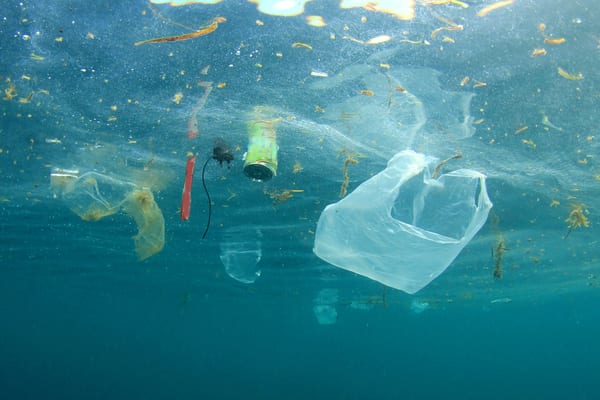Mounting research over the last few years has found microplastics in nearly every organ in the body, as well as in the bloodstream and in plaque that clogs arteries. Whether these ubiquitous pollutants can reach the human brain has been a primary concern for scientists.
Now, as NBC News reports, it appears their fears were not unfounded. Scientists in Brazil have found microplastics in the brain tissue of cadavers, according to a new study published Monday in the journal JAMA Network Open.
This research looked at a part of the brain called the olfactory bulb, which processes information about smell. Humans have two olfactory bulbs, one above each nasal cavity. Connecting the olfactory bulb and the nasal cavity is the olfactory nerve. Some researchers worry the olfactory pathway could be an entry point for microplastics getting into the brain, beyond the olfactory bulb.
“Previous studies in humans and animals have shown that air pollution reaches the brain, and that particles have been found in the olfactory bulb, which is why we think the olfactory bulb is probably one of the first points for microplastics to reach the brain,” said lead study author Dr. Thais Mauad, an associate professor of pathology at the University of São Paulo Medical School in Brazil.
Mauad and her team took samples of olfactory bulb tissue from 15 cadavers of people who died between the ages of 33 and 100. Samples from eight of the cadavers contained microplastics — tiny bits of plastic that ranged from 5.5 micrometers to 26.4 micrometers in size.
In total, the researchers found 16 plastic fibers and particles in the tissues. The smallest were slimmer than the diameter of a human red blood cell, which measures about 8 micrometers. The most common type of plastic they found was polypropylene, followed by polyamide, nylon and polyethylene vinyl acetate. “Propylene is everywhere, in furniture, rugs, clothes,” Mauad said. “We know the place we are most exposed to particles is indoors, because all of our homes are full of plastic.”
Matthew Campen, a toxicologist at the University of New Mexico who has studied microplastics in the brain, said the presence of microplastics in the olfactory bulb “is unique but not terribly surprising. The nose is a major point of defense to keep particles and dust out of the lungs,” Campen wrote in an email. “So seeing some plastics in the olfactory system, especially given how they are being found everywhere else in the body, is completely expected.”
While it wasn’t noted in the study, Campen said he believes the samples likely also contained many nanoplastics, which range in size from 1 to 1,000 nanometers. A strand of human DNA is about 2.5 nanometers thick. (One micrometer is 1,000 times larger than a nanometer.)
The presence of microplastics in the olfactory bulb doesn’t automatically mean there are microplastics elsewhere in the brain, such as regions related to cognition. Whether these particles can actually reach these parts of the brain through the olfactory bulb is still not clear. “There is evidence that very small airborne particles can move to the brain via the olfactory bulb, but this is not known to be a major route of trafficking material to the brain,” Campen said.
The olfactory system is the pathway between the nose and the brain. The system detects smell by processing the tiny odor molecules that waft off of various objects, such as baking bread or a bouquet of flowers. Those molecules stimulate olfactory nerves, and the signals are processed in the brain as smell. Other particles can travel these same routes. Although rare, amoebas such as Naegleria fowleri — larger than the size of the microplastics found in the study — can get into the brain through the olfactory nerve. “We thought that if bacteria can pass through this pathway, microplastics might be able to, too,” Mauad said.
Campen said it’s more likely that nanoplastics enter the brain through the bloodstream, which picks up plastic bits from the lungs or digestive tract, rather than the olfactory bulb. However, it’s extremely difficult for particles, even those in pharmaceuticals, to enter the brain through the blood. That’s because the brain is surrounded by a semipermeable membrane called the blood-brain barrier. Research on microplastics in the body is still new, and whether these microscopic bits of plastic can pass through the blood-brain barrier in humans is still a big question.
Most of what scientists understand about how the 4,000 chemicals used to make plastic, and the pieces themselves, may harm health has been limited to animal studies. One recent study showed that exposure to microplastics through drinking water over the course of three weeks caused cognitive changes in mouse brains. The particles were also able to cross the blood-brain barrier.
Earlier this year, a study was the first to link the presence of microplastics to higher rates of mortality in people who had higher levels of microplastics in arterial plaque. “We know there is an inflammatory reaction when cells are exposed to microplastics in the lab,” said Dr. Mary Johnson, an environmental health research scientist at Harvard T.H. Chan School of Public Health, who was not involved in the research.
Johnson noted that neurological diseases including dementia have been linked to exposure to air pollution. “The thought is, could microplastics, could that be a part of the puzzle?” she said. “Part of the concern is not just the particle itself, it’s the fact that those plastics have additives in them, some of them we know are potentially toxic.”
—
Photo Credit: Rich Carey / Shutterstock.com
